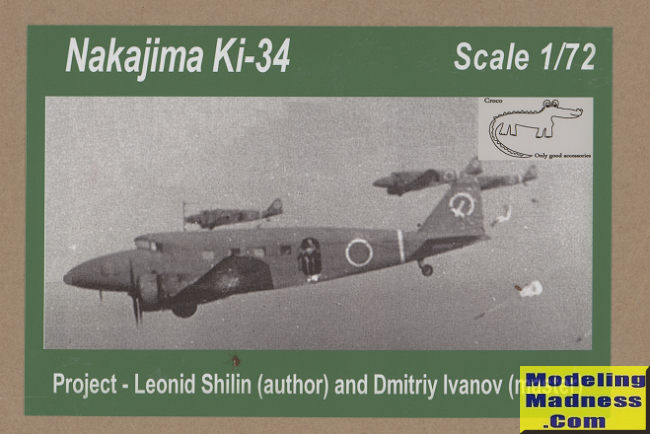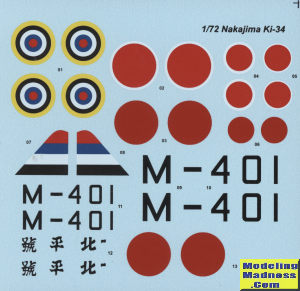
Croco 1/72 Nakajima Ki-34 (updated preview - See Below)
| KIT #: | |
| PRICE: | $ |
| DECALS: | Two options |
| REVIEWER: | Scott Van Aken |
| NOTES: | Resin kit |

| HISTORY |
The Ki-34 was originally designed as a civil transport. Nakajima Aircraft Company, which had the license-production rights to the Douglas DC-2, began design work in 1935 on a smaller twin engine airliner for routes which did not have the capacity to justify use of the larger DC-2. The initial design was designated AT-1, and after numerous design iterations, flew as a prototype designated AT-2 on 12 September 1936. The design was all metal, except for the flight control surfaces, which were plywood. The wings used a multi-cell cantilever design. The prototype was fitted with 432 kW (580 hp) Nakajima Kotobuki 2-1 radial engines with fixed pitch wooden propellers, which were replaced in production models with Kotobuki-41 529 kW (710 hp) nine-cylinder radial engines, with variable pitch metal propellers.
A total of 32 AT-2s were produced for Imperial Japanese Airways (Dai Nippon Koku KK) and Manchukuo National Airways, operating on scheduled routes between Tokyo and Hsinking, Tokyo and Tianjin, and within Manchukuo. These aircraft remained in operational service until the surrender of Japan in August 1945.
With a high demand for increased military transport capability after the start of the Second Sino-Japanese War in 1937, the Imperial Japanese Army adapted the AT-2 design for military use by fitting with more powerful Nakajima Ha-1b radial engines and re-designating the aircraft as the Army Type 97 Transport and Ki-34. The initial 19 aircraft were produced by Nakajima Aircraft, and another 299 aircraft were subsequently produced by the Army-affiliated Tachikawa Hikoki K.K.. The final airframe was delivered in 1942.
In operational service, the Ki-34 was used as a utility aircraft for liaison and communications duties, and for paratrooper training and Special Forces operations.
At a later date, some aircraft were transferred to the Imperial Japanese Navy, where they were known as the Navy Type AT-2 Transport or Nakajima L1N1. Several were also transferred to the air force of the Japanese puppet state of China-Nanjing in 1942.
| THE KIT |
 The
kit is nicely molded with fine engraved panel lines. Typical of the genre, you
will need to clean up every part as there is some flash on it all. I found a few
air pockets, but they were quite small and those of us who have built kits like
this should be used to finding things like this. Rather than show a mass of
small resin parts embedded in resin wafers, I thought I'd provide some of the
major bits as an example.
The
kit is nicely molded with fine engraved panel lines. Typical of the genre, you
will need to clean up every part as there is some flash on it all. I found a few
air pockets, but they were quite small and those of us who have built kits like
this should be used to finding things like this. Rather than show a mass of
small resin parts embedded in resin wafers, I thought I'd provide some of the
major bits as an example.  s
detail stuff form the interior and landing gear, while the other is an exploded
view of the general airframe. There is a third that shows the markings and
photos on which the markings are based. OK, not standard stuff, but not really a
major deal and one that those who are building these sorts of kits should be
able work with. No readable color information is supplied (notes are written in
Russian).
s
detail stuff form the interior and landing gear, while the other is an exploded
view of the general airframe. There is a third that shows the markings and
photos on which the markings are based. OK, not standard stuff, but not really a
major deal and one that those who are building these sorts of kits should be
able work with. No readable color information is supplied (notes are written in
Russian). Croco
had provided some updates in terms of parts for this kit. First of all, they
have added some cabin interior detailing in terms of fuselage framing. This
should provide something to look at if you build the door open. It also adds
strength to the fuselage halves. They have also provided a cabin floor piece,
which will help with stiffening as well.
Croco
had provided some updates in terms of parts for this kit. First of all, they
have added some cabin interior detailing in terms of fuselage framing. This
should provide something to look at if you build the door open. It also adds
strength to the fuselage halves. They have also provided a cabin floor piece,
which will help with stiffening as well.  Secondly,
they realized that the kit's resin gear would probably not work well holding up
the model so have produced the landing gear with metal reinforcement. This
applies to the axle stubs on it as well. The tail gear got the same treatment. I
Secondly,
they realized that the kit's resin gear would probably not work well holding up
the model so have produced the landing gear with metal reinforcement. This
applies to the axle stubs on it as well. The tail gear got the same treatment. I
 know these are
not easy to make so two thumbs up to Croco for putting in the extra effort.
know these are
not easy to make so two thumbs up to Croco for putting in the extra effort. | CONCLUSIONS |
I am a huge fan of these sorts of subjects and am very pleased to see them being released in some form or another. Somewhere in the piles, I have a Ki-57, which is what augmented/replaced this aircraft in service and should really find the time to build it.
| REFERENCES |
https://en.wikipedia.org/wiki/Nakajima_Ki-34
May 2019
Copyright ModelingMadness.com. All rights reserved.
Thanks to Croco for the preview item. Contact them at sniff23@inbox.lv for
information and costs. If you would like your product reviewed fairly and fairly quickly, please contact the editor
or see other details in the
Note to
Contributors. Back to the Main Page
Back to the Review
Index Page
Back to the Previews Index Page